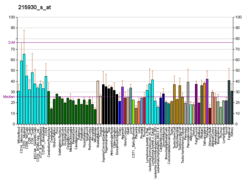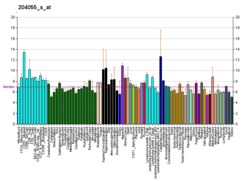CTAGE5
Cutaneous T-cell lymphoma-associated antigen 5 is a protein that in humans is encoded by the CTAGE5 gene.[3][4][5]
References
- ↑ "Human PubMed Reference:".
- ↑ "Mouse PubMed Reference:".
- ↑ Heckel D, Brass N, Fischer U, Blin N, Steudel I, Tureci O, Fackler O, Zang KD, Meese E (Dec 1997). "cDNA cloning and chromosomal mapping of a predicted coiled-coil proline-rich protein immunogenic in meningioma patients". Hum Mol Genet. 6 (12): 2031–41. doi:10.1093/hmg/6.12.2031. PMID 9356211.
- ↑ Eichmuller S, Usener D, Dummer R, Stein A, Thiel D, Schadendorf D (Mar 2001). "Serological detection of cutaneous T-cell lymphoma-associated antigens". Proc Natl Acad Sci U S A. 98 (2): 629–34. doi:10.1073/pnas.021386498. PMC 14639. PMID 11149944.
- ↑ "Entrez Gene: CTAGE5 CTAGE family, member 5".
External links
- Human CTAGE5 genome location and CTAGE5 gene details page in the UCSC Genome Browser.
Further reading
- Bonaldo MF, Lennon G, Soares MB (1997). "Normalization and subtraction: two approaches to facilitate gene discovery". Genome Res. 6 (9): 791–806. doi:10.1101/gr.6.9.791. PMID 8889548.
- Comtesse N, Reus K, Meese E (2001). "The MGEA6 multigene family has an active locus on 14q and at least nine pseudogenes on different chromosomes". Genomics. 75 (1–3): 43–8. doi:10.1006/geno.2001.6576. PMID 11472066.
- Comtesse N, Niedermayer I, Glass B, et al. (2002). "MGEA6 is tumor-specific overexpressed and frequently recognized by patient-serum antibodies". Oncogene. 21 (2): 239–47. doi:10.1038/sj.onc.1205005. PMID 11803467.
- Strausberg RL, Feingold EA, Grouse LH, et al. (2003). "Generation and initial analysis of more than 15,000 full-length human and mouse cDNA sequences". Proc. Natl. Acad. Sci. U.S.A. 99 (26): 16899–903. doi:10.1073/pnas.242603899. PMC 139241. PMID 12477932.
- Usener D, Schadendorf D, Koch J, et al. (2003). "cTAGE: a cutaneous T cell lymphoma associated antigen family with tumor-specific splicing". J. Invest. Dermatol. 121 (1): 198–206. doi:10.1046/j.1523-1747.2003.12318.x. PMID 12839582.
- Ota T, Suzuki Y, Nishikawa T, et al. (2004). "Complete sequencing and characterization of 21,243 full-length human cDNAs". Nat. Genet. 36 (1): 40–5. doi:10.1038/ng1285. PMID 14702039.
- Gerhard DS, Wagner L, Feingold EA, et al. (2004). "The status, quality, and expansion of the NIH full-length cDNA project: the Mammalian Gene Collection (MGC)". Genome Res. 14 (10B): 2121–7. doi:10.1101/gr.2596504. PMC 528928. PMID 15489334.
- Kimura K, Wakamatsu A, Suzuki Y, et al. (2006). "Diversification of transcriptional modulation: large-scale identification and characterization of putative alternative promoters of human genes". Genome Res. 16 (1): 55–65. doi:10.1101/gr.4039406. PMC 1356129. PMID 16344560.
- Olsen JV, Blagoev B, Gnad F, et al. (2006). "Global, in vivo, and site-specific phosphorylation dynamics in signaling networks". Cell. 127 (3): 635–48. doi:10.1016/j.cell.2006.09.026. PMID 17081983.
This article is issued from
Wikipedia.
The text is licensed under Creative Commons - Attribution - Sharealike.
Additional terms may apply for the media files.

